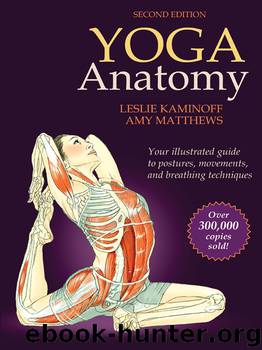Yoga Anatomy by Kaminoff Leslie

Author:Kaminoff, Leslie [Kaminoff, Leslie]
Language: eng
Format: epub
Tags: Manuel, USA, Anatomie, Yoga
ISBN: 9781450419864
Publisher: Democrite - Giga
Published: 2012-10-12T22:00:00+00:00
CONCLUSION
It was often a challenge to know what to say about the actions in the joints and muscles for each asana. Each body is unique. Each body has different ways of responding to gravity, different pathways for recruiting muscles, and a different amount of tone in the joint capsules and ligaments. Two people can use different muscles to create the same joint action and then have completely different sensations of the experience in the same asana. We each have our own way to distinguish between sensations of stretching and lengthening, working and holding, or pain and release.
In a few cases we list muscles that are lengthening but are not necessarily active—described as passively lengthening—to distinguish them from muscles that are actively lengthening in an eccentric contraction. For some people these muscles will have the sensation of stretching, but for others there will not be a sensation of stretching until far past an appropriate range of motion. For still others these muscles might actually be so easy to lengthen that they would do better to engage in an eccentric contraction and modulate the range of motion.
Our choices about how to move through an asana will depend on our starting condition. For example, if I have very open shoulders, then I might think about internally rotating the humerus relative to the scapula, while my neighbor with less mobility in the glenohumeral joint is rolling the arms open as much as she can. Both actions could be functional in adho mukha svanasana (downward-facing dog pose) because the point of the asana (on a body level) is not to do it right, but to find the relationship between all the parts of the body that will let the experience of the asana resonate throughout the whole body—cells, tissues, fluids, and systems.
The ways we initiate a movement, whether from the bones and muscles or from the endocrine system or the blood, have a tremendous impact on the quality of the movement. With practice and skillful observation we can see from the initiation how the movement will travel through the body and the effect it will have on the body systems. An understanding of what we are activating to move into an asana will help us understand the nature of the asana and the effect it has on the skeletal, muscular, nervous, and endocrine systems; the mind; and the spirit.
The asana is not just the final arrangement of the limbs and spine, but is the full process of coming into that arrangement. If we look at the process rather than the final product, we are able to develop variations that increase or decrease the challenge of the asana without feeling that we aren’t actually doing the asana until we get our head to our knee, our hands to the floor, or some other concrete goal. We are able to adapt the asana to the individual so that each person can find a unique embodiment of the asana.
Because yoga practice is fundamentally experiential, the information in this book is intended to be an inspiration to explore your own body.
Download
This site does not store any files on its server. We only index and link to content provided by other sites. Please contact the content providers to delete copyright contents if any and email us, we'll remove relevant links or contents immediately.
Bodyweight Strength Training by Jay Cardiello(7259)
Tools of Titans by Timothy Ferriss(7078)
Born to Run: by Christopher McDougall(6359)
Inner Engineering: A Yogi's Guide to Joy by Sadhguru(6000)
Asking the Right Questions: A Guide to Critical Thinking by M. Neil Browne & Stuart M. Keeley(4702)
The Fat Loss Plan by Joe Wicks(4309)
Bodyweight Strength Training Anatomy by Bret Contreras(4126)
Yoga Anatomy by Kaminoff Leslie(3764)
Science and Development of Muscle Hypertrophy by Brad Schoenfeld(3642)
Dynamic Alignment Through Imagery by Eric Franklin(3567)
The Four-Pack Revolution by Chael Sonnen & Ryan Parsons(3531)
ACSM's Complete Guide to Fitness & Health by ACSM(3524)
Yoga Anatomy by Leslie Kaminoff & Amy Matthews(3460)
Bodyweight Strength Training: 12 Weeks to Build Muscle and Burn Fat by Jay Cardiello(3432)
The Ultimate Bodybuilding Cookbook by Kendall Lou Schmidt(3395)
Exercise Technique Manual for Resistance Training by National Strength & Conditioning Association(3379)
Nutrition for Sport, Exercise, and Health by Spano Marie & Kruskall Laura & Thomas D. Travis(3298)
Nutrition for Sport, Exercise, and Health by Marie Spano & Laura Kruskall & D. Travis Thomas(3288)
Yoga Therapy by Mark Stephens(3280)
